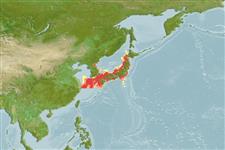Environment: milieu / climate zone / depth range / distribution range
Écologie
marin démersal; océanodrome (Ref. 51243). Subtropical; 45°N - 30°N
Northwest Pacific: southern Hokkaido to Kyushu and the southern Korean Peninsula (Ref. 559). Three morphotypes observed (reddish type; blackish type; brownish type), and may be reproductively isolated from each other (Ref. 44259).
Length at first maturity / Taille / Poids / Âge
Maturity: Lm ?, range 16 - ? cm
Max length : 35.9 cm TL mâle / non sexé; (Ref. 96735); poids max. publié: 800.00 g (Ref. 40637)
Juveniles associate with drifting seaweed. Plankton feeder (Ref. 12114, 12115). Viviparous (Ref. 34817).
Males established territories ranging from 12 to 70 sq. m; initiated courtship when females approached the territories; lateral display, rushing and turning movements were frequently observed during courtship. Mating pair formed about 30 min before copulation; the pair ascended to 1.5-2.0 m above bottom then males suddenly coiled around the body of females to copulate.
Masuda, H., K. Amaoka, C. Araga, T. Uyeno and T. Yoshino, 1984. The fishes of the Japanese Archipelago. Vol. 1. Tokai University Press, Tokyo, Japan. 437 p. (text). (Ref. 559)
Statut dans la liste rouge de l'IUCN (Ref. 130435: Version 2024-1)
Menace pour l'homme
Harmless
Utilisations par l'homme
Pêcheries: commercial; Aquaculture: commercial; pêche sportive: oui
Outils
Articles particuliers
Télécharger en XML
Sources Internet
Estimates based on models
Preferred temperature (Ref.
123201): 9.3 - 22.1, mean 17.3 °C (based on 52 cells).
Phylogenetic diversity index (Ref.
82804): PD
50 = 0.5000 [Uniqueness, from 0.5 = low to 2.0 = high].
Bayesian length-weight: a=0.01288 (0.00989 - 0.01677), b=3.02 (2.96 - 3.08), in cm total length, based on LWR estimates for this species (Ref.
93245).
Niveau trophique (Ref.
69278): 4.0 ±0.67 se; based on food items.
Generation time: 4.4 ( na - na) years. Estimated as median ln(3)/K based on 1
growth studies.
Résilience (Ref.
120179): Milieu, temps minimum de doublement de population : 1,4 à 4,4 années (K=0.25).
Fishing Vulnerability (Ref.
59153): Moderate vulnerability (38 of 100).
Nutrients (Ref.
124155): Calcium = 53.1 [20.6, 174.2] mg/100g; Iron = 0.62 [0.26, 1.68] mg/100g; Protein = 18.3 [17.0, 19.7] %; Omega3 = 0.645 [0.255, 1.731] g/100g; Selenium = 82.5 [29.3, 254.6] μg/100g; VitaminA = 10.6 [2.9, 40.2] μg/100g; Zinc = 0.447 [0.234, 0.827] mg/100g (wet weight);
